Here’s one that blew my mind not that long ago when I read about it. I wrote about this before. As an amateur astronomer who has been looking at the stars since I was a kid, I found this fact amazing.
My older sisters and I once found the Andromeda galaxy just above the constellation Andromeda. We were very excited to see that faint, fuzzy little patch of light that we figured was the whole Andromeda galaxy which is 2.5 million light years away from our own Milky Way galaxy.
We had to look at it with averted vision to actually see it nicely. BUT, we were wrong. We were not looking at the whole Andromeda galaxy.
THAT was only the bright centre of the galaxy we were looking at, bright because the stars are densest in the centre of the galaxy. It has a cute name, the Galactic Bulge.
If your eyes could gather light like a time lapse camera, and the faintest stars would become much brighter then you could actually see them, the Andromeda galaxy would look like this is the night sky beside the moon. What my sisters and I were actually looking at was the centre, the rest of the galaxy was too dim to be seen.
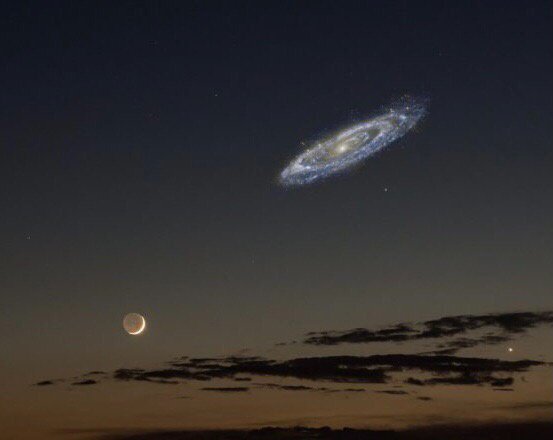
Can you imagine seeing this sight in the night sky? It’s there, you just can’t see it, the stars are too dim.
Another astonishing thing is that the Andromeda galaxy and our Milky Way galaxy are barrelling toward each other at 250,000 MPH OR 402,336 KPH. In around 4.5 billion years, the two galaxies will collide with each other. Devastating? Not really. The stars in the galaxies are so distant, there will be few if any colliding stars.
The galaxies will pass through each other however, gravity will pull them back together and the two galaxies will form a giant, elliptical galaxy.
When the two galaxies collide, the Solar System will be swept out three times farther from the galactic core than its current distance. They also predict a 12% chance that the Solar System will be ejected from the new galaxy sometime during the collision.
Such an event would have no adverse effect on the system and the chances of any sort of disturbance to the Sun or planets themselves may be remote.
However, by that time, our sun would have gone through its red giant stage and would have already consumed Mercury and Venus. Earth will be very close but it’s water would have been boiled away long ago and Earth will be at that time devoid of all life. A crispy cinder would be all that is left of that majestic, life filled world.
Hang on to your hats. Our solar system located in the Orion arm of our own Milky Way galaxy which is 100,000 light years across and swirling around like a giant frisbee, travels at an average speed of 515,000 mph (828,000 km/h).
Even at this rapid speed, the solar system would take about 230 million years to travel all the way around the Milky Way. That’s one hell of a merry go round ride!
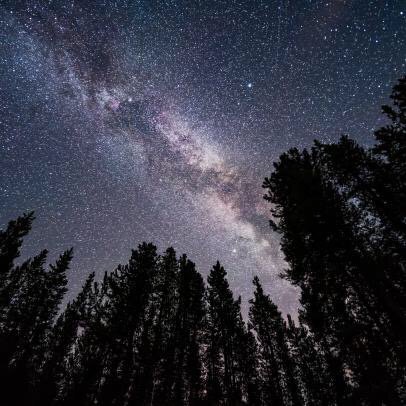
Above. On a dark night far away from city lights, you can see a part of our own Milky Way galaxy. You are looking toward the centre of our galaxy where stars are the densest.
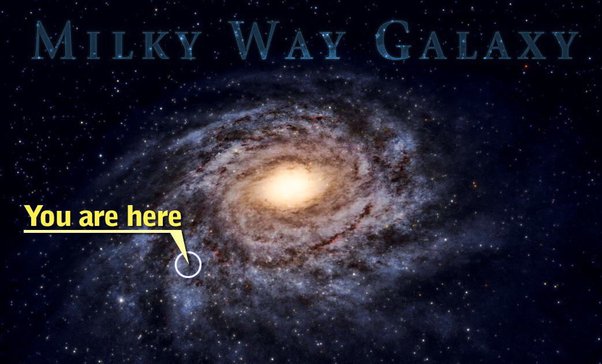
Our Milky Way Galaxy above showing where our solar system is located.
Okay, one more mind blow. The galaxies Andromeda and the Milky Way are actually now touching. Each galaxy has what is called a Galactic Halo, gas, dust and stray stars. It was discovered that the galactic halo of our galaxy and Andromeda stretch out a lot further than thought.
In other words, it’s the faint halos of the galaxies that indeed appear to have started to touch one another. Thus, in a manner of speaking, the collision between our two galaxies has already started.
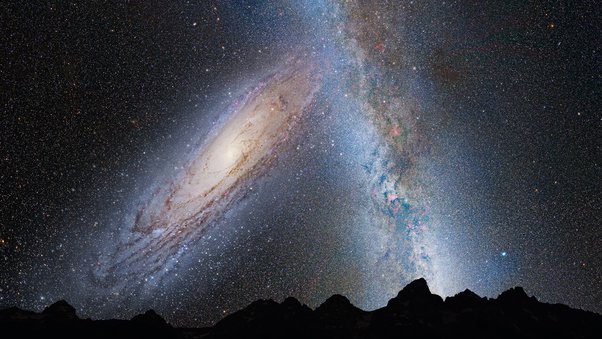
Andromeda and our Milky Way on collision course.
When the galaxies do meet, it will make for a pretty sight from earth. On approach, the Andromeda galaxy will warp the band of the Milky Way across our sky. Eventually, the galaxies’ cores will merge. However, by then, there will be no one on earth to see this sight.
It already has happened. Ten billion years ago another, smaller galaxy collided with our Milky Way. Again, stars did not smash into each other but the galaxies passed through each other like ghosts. In time, the smaller galaxy was pulled in and joined the Milky Way with new, alien stars and gas.
And it happened again with a dwarf galaxy four billion years ago. So Andromeda will not be the first galaxy to collide with ours but it will be the largest. It’s 50% larger than our Milky Way.
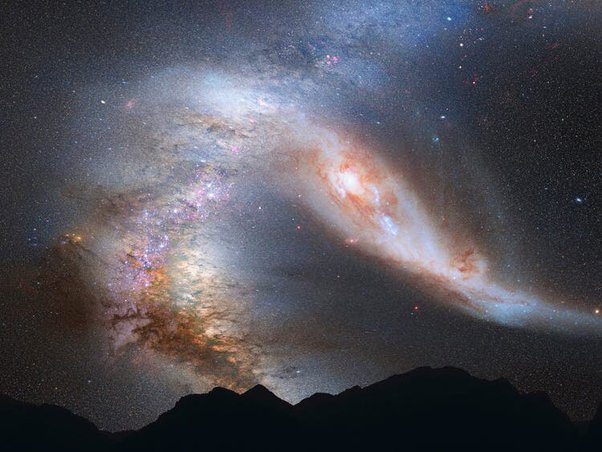
The universe could have begun without a beginning.
Well that’s just utter nonsense if you ever heard it, right? I literally just contradicted myself. True, but let me explain what I’m trying to convey with that sentence.
A common problem people have with trying to come to terms with the Big Bang is the weird, very uncomfortable feeling of the word beginning in the context of the universe.
And its a very reasonable feeling to have, after all, any time we define a “beginning” for something, its not really the beginning. There was always something that preceded it. Cause and effect.
Your life didn’t begin with just you, it began with your parents. Before your parents, there was all the life on earth that existed before your parents as your ancestors. Before that, you had nucleic acids self-replicating into other nucleic acids.
Those nucleic acids were made out of heavy elements forged inside a supernova explosion. The star that made that explosion was born from that of other stars, back to the first stars which were made from the first hydrogen and helium of the universe.
That first matter coalesced from energy, as energy began to take on distinguishable forms after the universe expanded enough that all the physical forces and interactions were no longer identical. And before that…
Here’s where things always get dicey.
You probably have seen a diagram like this before:
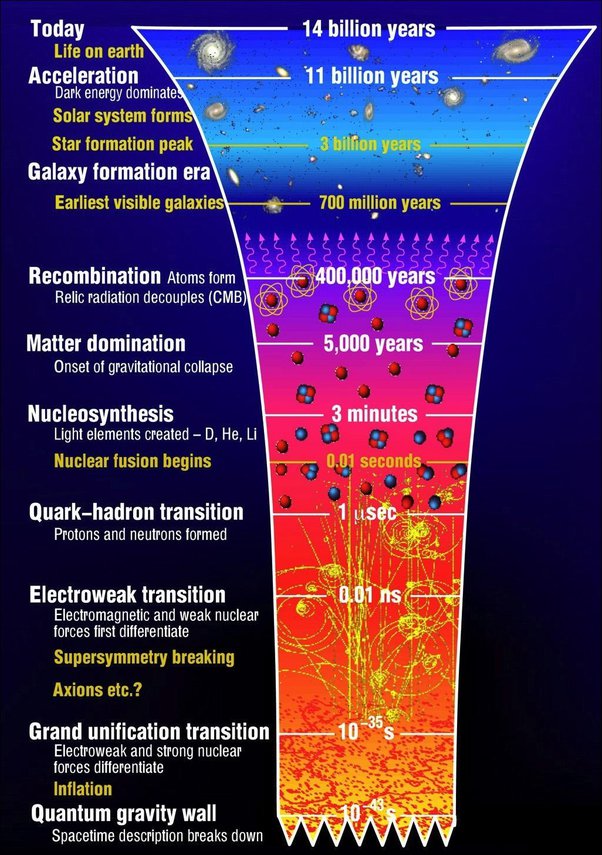
(Image Credit: University of Cambridge/CTC
[1])
Let’s talk about this thing at the bottom called the quantum gravity wall.
There’s a point, about 10−4310−43 seconds after the “beginning” (whatever that means), before which we can no longer even describe events.
During this first 10−4310−43 seconds, called the Planck era, information, travelling at the speed of light (the fastest anything can travel), will have only had the opportunity to travel one Planck length. One Planck length, about 10−3510−35 meters, is the interval over which all points in space and time fluctuate enough that our entire coordinate system breaks down.
This means not only can we no longer describe an object’s position effectively, but we can’t even describe whether an event preceded or followed another event.
Perhaps we just need better physics (maybe quantum gravity) to understand how the universe behaves on this scale, but right now we are at a loss. The weird part though is that the universe doesn’t necessarily need to be well defined on these scales.
For this reason, these fluctuations are often called quantum foam. It’s perfectly reasonable for spacetime to always be fluctuating on these scales, but still be well defined on the larger scales. Everything is fluctuating on quantum scales and mostly well defined on the macroscopic. That’s basically the crux of all quantum mechanics. There’s no reason why gravity can’t be the same way.
The problem is then, how do we go about describing the first 10−4310−43 seconds when we can’t even describe causality effectively during this period of time?
Maybe causality itself isn’t defined on these scales. That would be weird. Without causality, can we even really define time anymore? Or space for that matter? Or anything? Did this period of time really last only 10−4310−43 seconds then? What would that even mean if “duration” has no meaning?
The chain of events that represents the course of the entire history of the universe might be asymptotic. This means that as we approach this point that we’re calling t = 0, our ability to describe events is no longer defined, because the continuity of causality itself asymptotes.
The universe began as an infinitely fluctuating, infinitely dense, infinitely compact, infinitely energetic, infinitely sized, soup of energy. And it existed for an undefinable amount of time in this way, until it expanded enough that information of any kind could propagate longer than a Planck length, and causality came into clearer definition. This is what we have been effectively calling the Big Bang.
So maybe that makes the Big Bang an effective beginning to the universe, but perhaps the universe just “existed” in an undefined state, for an undefined amount of time, before it came into clarity. But if nothing is defined, then it effectively doesn’t exist yet anyways.
This is a very unsatisfactory answer for most people, since it makes it sound like the universe just fizzled itself into existence.
…zzzzzzzzZZZZZOOP and there is the whole infinite universe.
It just doesn’t feel right that we can have existence without something preceding existence right? The trouble is, if something preceded existence, then clearly we haven’t included all of existence in our very definition of what existence comprises of.
So, regardless of our discussion of our own observable universe, existence is either infinite or it isn’t. And depending on who you ask, you’ll always get a different opinion on the matter, because, well, we don’t actually really know yet.
But the Planck era represents a pretty gigantic roadblock for us being able to figure that out. Unless we get some pretty divine insight from developing a grand unified theory of everything, including a fully fleshed out metric for quantum gravity and how it relates to the other physical forces, the Big Bang pretty much signifies the real beginning of everything, even though it really wasn’t a very exciting beginning, or even really a true beginning.
If anything, it was just a phase transition from not being able to describe causality to being able to describe it.
And then, after reaching this conclusion, we get the even spookier question:
Well… Why?
An infinitely near-infinitely compacted universe (meaning, infinitely close to being infinitely dense in energy) would be immediately driven to start expanding. The moment time exists, the universe is expanding.
Perhaps the progression of time is tied to the progressing rate of expansion of the universe rather than the other way around. Or perhaps they are actually the same physical concept. Perhaps all of this is tied together in some unbelievably elegant way that we just haven’t figured out yet.
And yet still that weird question hangs in the air.
How does anything even exist in the first place?
Welcome to the astrophysicist’s version of an existential crisis.
For all we know, the answer to this question could just be a tautology. If existence at one point didn’t exist, then it wouldn’t just start existing, because there wouldn’t exist anything to beget its existence, because that’s what existence is. Therefore it must start by existing in the first place, and there simply was no before.
Yeah, it doesn’t sit well with me either. But that is the universe that we observe.
The word “before” doesn’t even make much sense if time didn’t exist yet. But perhaps there is another temporally infinite plane of existence beyond our observable universe from which our universe was born.
Multiverse and cyclical universe theories are popular and certainly not unheard of, not to mention countless religious interpretations on the origin of the universe.
But we have yet to see particularly strong tangible evidence for any of these yet. Some would argue that existence itself is the evidence, but that really is the dilemma we have here. We have the universe that we observe to work with, and that is what we observe, and that presents us with what we can say about the universe.
Beyond that, well, I’ll leave that to the reader to ponder over.
For me, the most mindblowing fact about space has always been in the name. To understand what I mean by that, let’s start off with a simple scenario.
Picture this: it’s a nice sunny afternoon in October, the perfect time for a picnic. In fact, imagine that we’re observing such a picnic from above:

As the number on the top left indicates, we’re looking at a square picture that’s 1 meter wide. But let’s see what happens if we zoom out a bit:

We’re now staring at a square area 10 meters wide. It’s already becoming difficult to make out the people or the picnic items.
What if we try zooming out even further; say, 100 meters wide?
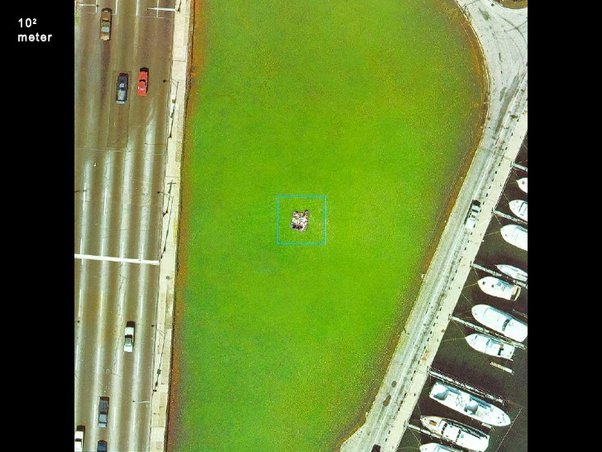
Nice freeway we’ve got there. But what if kept zooming out farther?

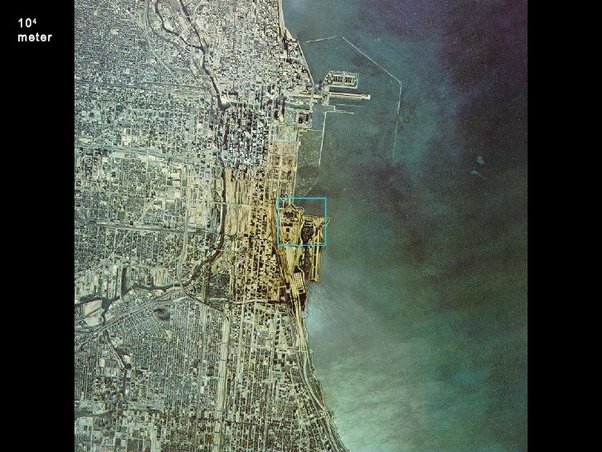
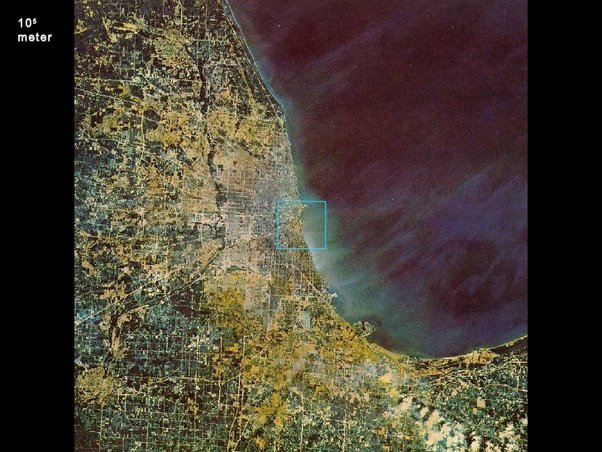
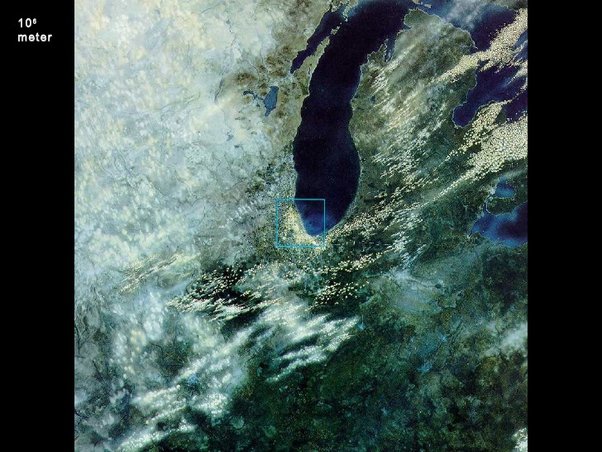
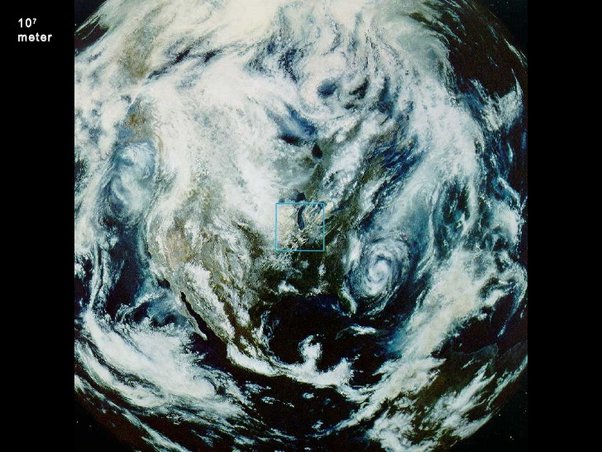
We’re now looking at a square 107107 (10,000,000) meters wide. You can probably recognise this as a section of the planet we call home, Earth. Seems like a pretty big picture compared to our picnic setting, no?
But as we zoom out further, even the Blue Planet begins to look quite small:
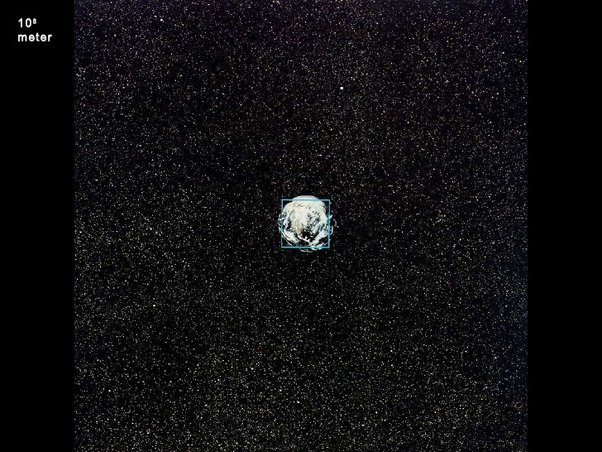
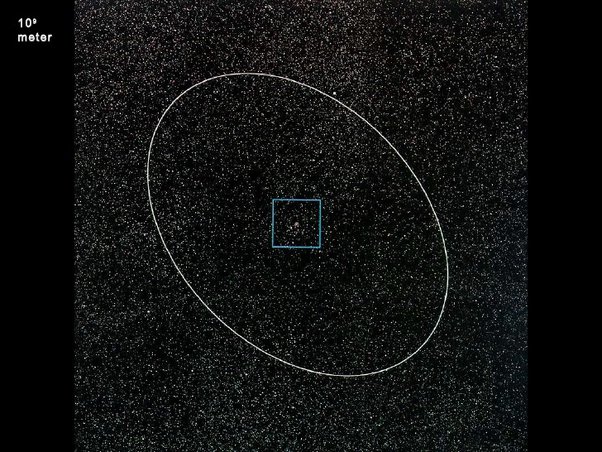
We’re now at 109109 (1,000,000,000) meters wide. The elliptical orbit you see is the path the Moon traverses around our planet. Interestingly, for a satellite that we catch a glimpse of every clear night, it certainly appears to be quite far away.
Let’s go out even further:
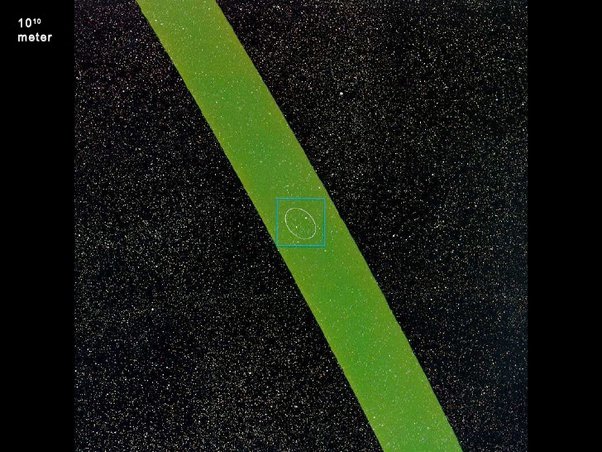
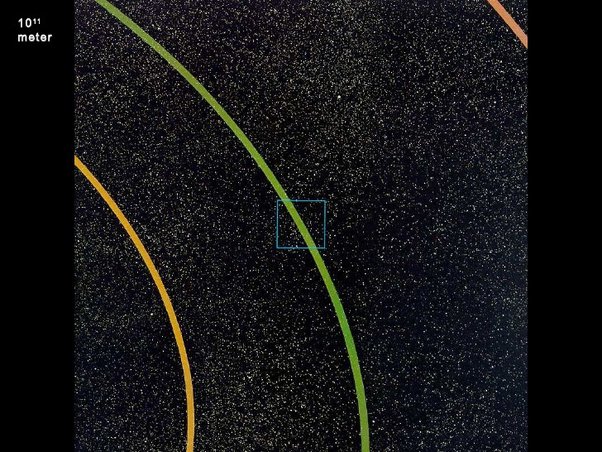
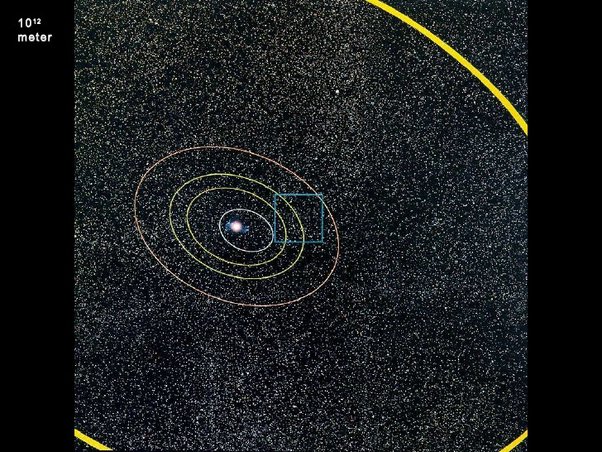
Now we’re at 10121012 meters wide. This is a glimpse of the inner part of our Solar System; as you can see, the green ellipse in our picture presents the orbit the Earth makes around the Sun.
But we’ve still got quite a way to go, you see:
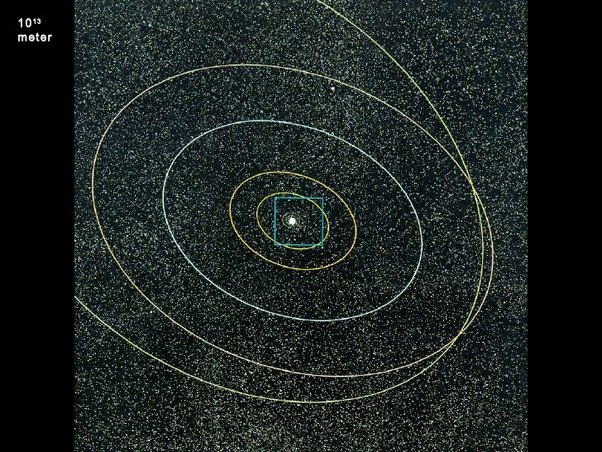
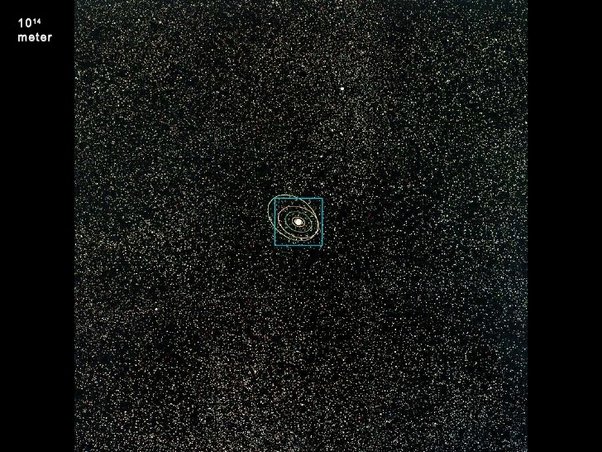
We’re now at 10141014 meters wide. The planets are essentially invisible at this point; even the Sun is but a speck in the distance.
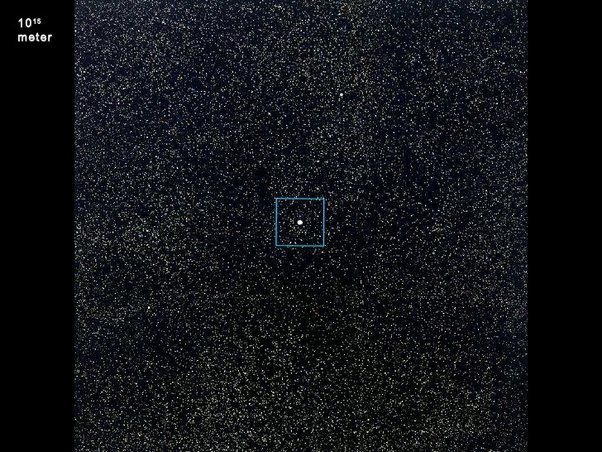
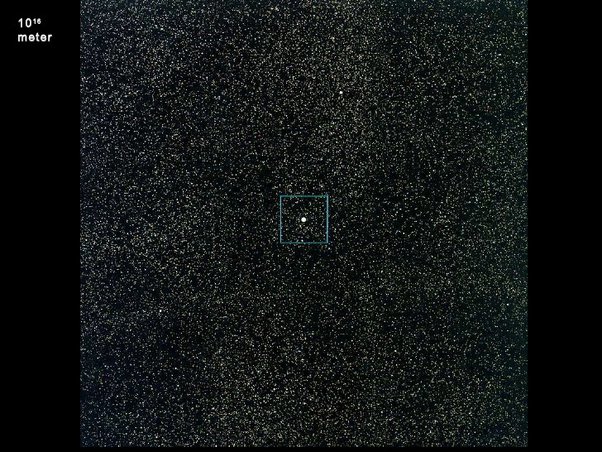
We’re now staring at a picture 10161016 meters wide, or what astronomers call a “light year.” Essentially, light travelling at maximum speed would take a whole Earth year to cover this distance.
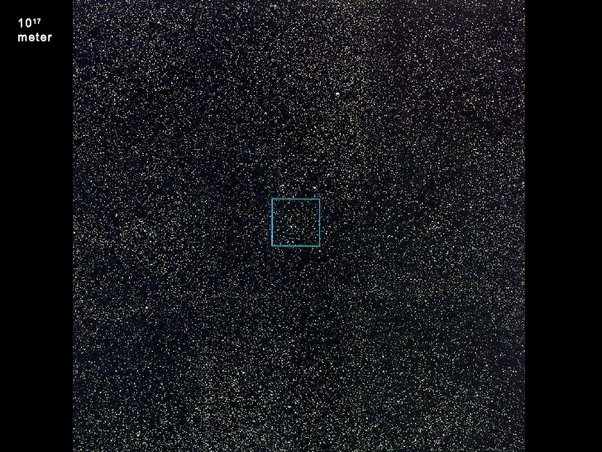
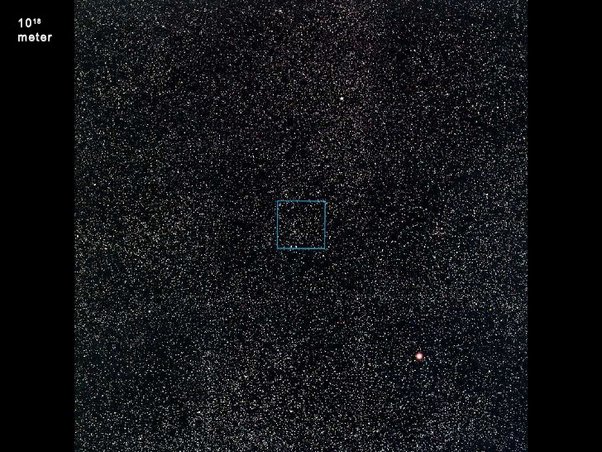
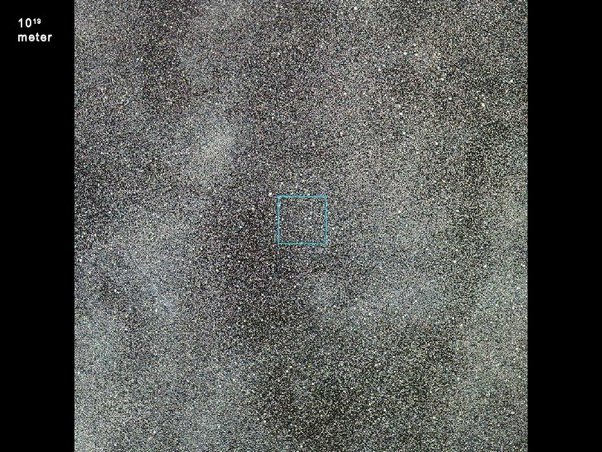
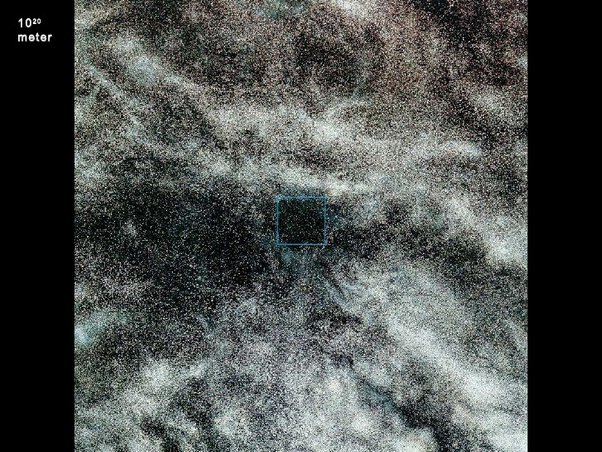
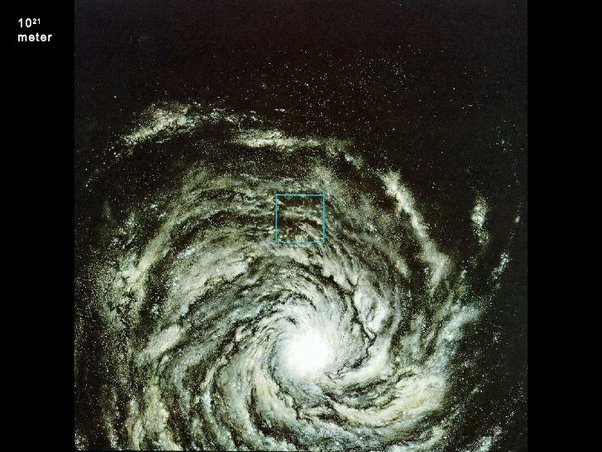
We’re now at 10211021 meters wide—that’s a trillion billion meters, to be precise.
That tiny blue square at the centre represents the section which contains our Solar System and planet Earth. They are now truly inconceivable dots on the galactic scale, lost among the forest of stars and planets that populate the Milky Way.
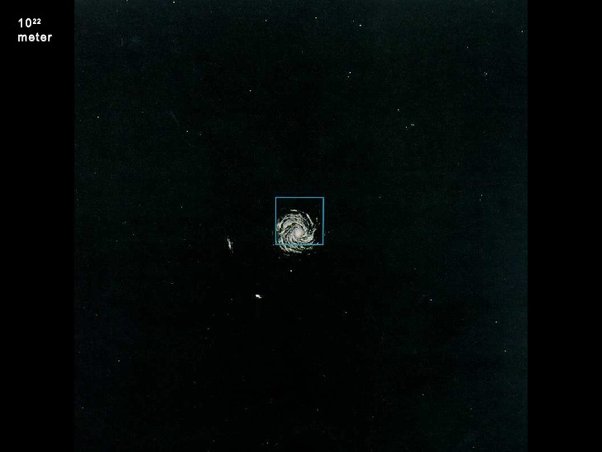
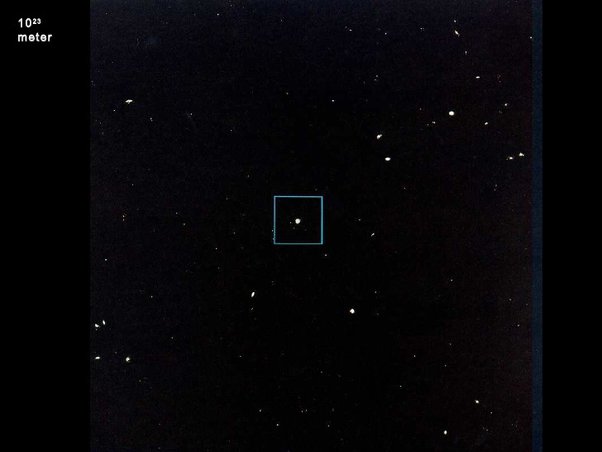
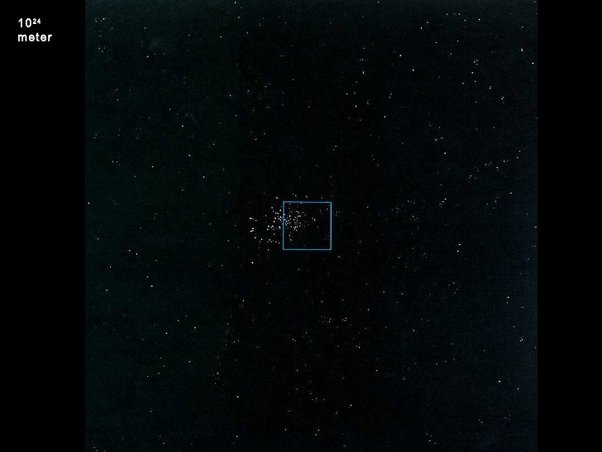
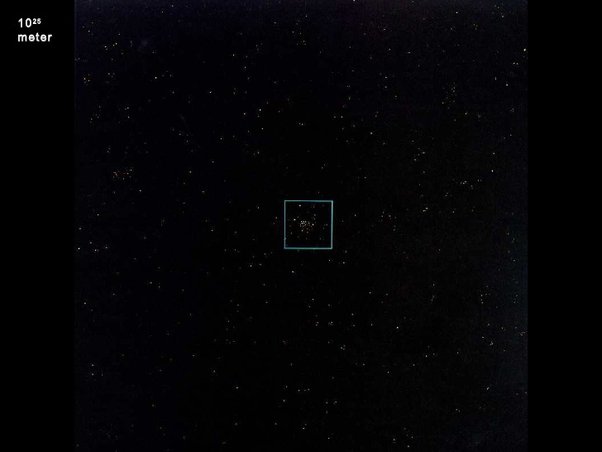
At last, we reach the edge of our travels. This is a picture 10251025 meters wide; the Milky Way galaxy and the cluster within it sits are now inconceivable in the vastness of the void.
This is space at its finest.
The above photographs are stills from a short film named The Powers of Ten (1977).
[1] Directed by Charles and Ray Eames, the intention was to demonstrate the relative scale of the cosmos with respect to an exponential scale—specifically, the powers of ten.
Just to recap: if we start from the square one meter wide, it takes just eight steps before we’re already staring at Earth from outer space. Another six steps and we’re looking at the Solar System from a distance; seven steps further and we’re face to face with the Milky Way. Then all of it virtually disappears by the time we hit the twenty-fifth power.
But where are all the stars and galaxies? You would think we would see a multitude of cosmic phenomena all around; instead, we’re greeted with the cold and ominous setting of pitch blackness.
Well, while it seems like a bleak picture, to say that this is “empty” space would be a bit fallacious. In fact, there’s a lot going on in this picture that we don’t see, because such elements don’t interact with photons (light particles) and electrons.
In fact, there’s no such thing as true empty space. There are always aspects at play in any pocket of the universe: even if you tried to remove any trace of matter and energy from an area, you would still be leaving quantum fluctuations unaccounted for; these are phenomena explained by the field of quantum physics.
We started this answer with a simple idea: trying to comprehend the vastness the universe, only to be greeted by a great silent void.
Yet it appears even this is misleading; there’s more to the cosmos than meets the eye, more than we can even begin to comprehend. The deeper we dig, the more questions we have. Why is the universe expanding? What is it expanding into? What is the fate of the cosmos?
But remember what I said at the start? For me, the most mindblowing fact about space has always been in the name.
That brings us to perhaps the biggest question of all is: What is space? If there’s no such thing as empty space, then what really is space? What is this fabric of reality, this structure that holds everything and everyone we hold dear?
Is space really space?
NOTE: Just to clarify, most of these images are actually real, either obtained by the filmmakers or through astrophotography provided by NASA. That said, this film doesn’t actually give us a glimpse of the Milky Way. Rather, it uses imagery of other areas in space to give us an approximate idea of the scale of the cosmos relative to our location.






